初中英语教学案例参考
初中英语课堂教学设计案例优秀9篇
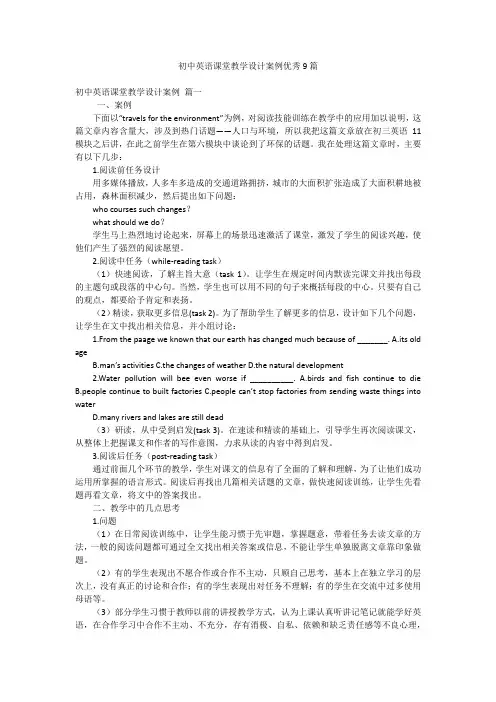
初中英语课堂教学设计案例优秀9篇初中英语课堂教学设计案例篇一一、案例下面以“travels for the environment”为例,对阅读技能训练在教学中的应用加以说明,这篇文章内容含量大,涉及到热门话题——人口与环境,所以我把这篇文章放在初三英语11模块之后讲,在此之前学生在第六模块中谈论到了环保的话题。
我在处理这篇文章时,主要有以下几步:1.阅读前任务设计用多媒体播放,人多车多造成的交通道路拥挤,城市的大面积扩张造成了大面积耕地被占用,森林面积减少,然后提出如下问题:who courses such changes?what should we do?学生马上热烈地讨论起来,屏幕上的场景迅速激活了课堂,激发了学生的阅读兴趣,使他们产生了强烈的阅读愿望。
2.阅读中任务(while-reading task)(1)快速阅读,了解主旨大意(task 1)。
让学生在规定时间内默读完课文并找出每段的主题句或段落的中心句。
当然,学生也可以用不同的句子来概括每段的中心。
只要有自己的观点,都要给予肯定和表扬。
(2)精读,获取更多信息(task 2)。
为了帮助学生了解更多的信息,设计如下几个问题,让学生在文中找出相关信息,并小组讨论:1.From the paage we known that our earth has changed much because of _______. A.its old ageB.man’s activitiesC.the changes of weatherD.the natural development2.Water pollution will bee even worse if __________. A.birds and fish continue to dieB.people continue to built factoriesC.people can’t stop factories from sending waste things into waterD.many rivers and lakes are still dead(3)研读,从中受到启发(task 3)。
初一英语教学实践案例(3篇)
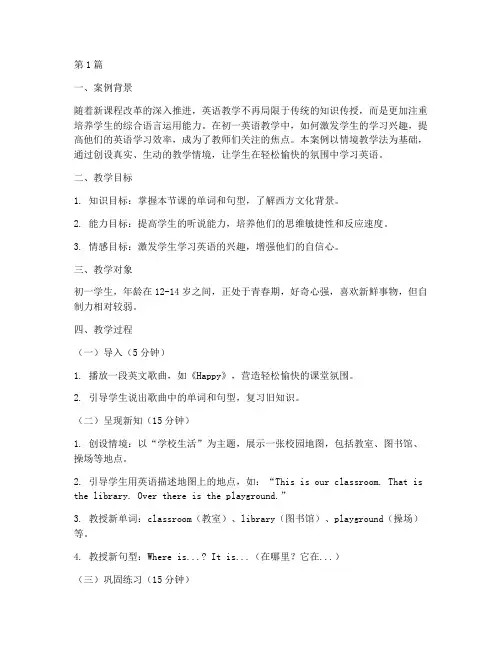
第1篇一、案例背景随着新课程改革的深入推进,英语教学不再局限于传统的知识传授,而是更加注重培养学生的综合语言运用能力。
在初一英语教学中,如何激发学生的学习兴趣,提高他们的英语学习效率,成为了教师们关注的焦点。
本案例以情境教学法为基础,通过创设真实、生动的教学情境,让学生在轻松愉快的氛围中学习英语。
二、教学目标1. 知识目标:掌握本节课的单词和句型,了解西方文化背景。
2. 能力目标:提高学生的听说能力,培养他们的思维敏捷性和反应速度。
3. 情感目标:激发学生学习英语的兴趣,增强他们的自信心。
三、教学对象初一学生,年龄在12-14岁之间,正处于青春期,好奇心强,喜欢新鲜事物,但自制力相对较弱。
四、教学过程(一)导入(5分钟)1. 播放一段英文歌曲,如《Happy》,营造轻松愉快的课堂氛围。
2. 引导学生说出歌曲中的单词和句型,复习旧知识。
(二)呈现新知(15分钟)1. 创设情境:以“学校生活”为主题,展示一张校园地图,包括教室、图书馆、操场等地点。
2. 引导学生用英语描述地图上的地点,如:“This is our classroom. That is the library. O ver there is the playground.”3. 教授新单词:classroom(教室)、library(图书馆)、playground(操场)等。
4. 教授新句型:Where is...? It is...(在哪里?它在...)(三)巩固练习(15分钟)1. 游戏环节:进行“找朋友”游戏,让学生用所学单词和句型描述自己,如:“I am in the classroom. I like reading books.”2. 小组合作:分组讨论,设计一个校园地图,并用英语标注地点。
3. 角色扮演:模拟校园生活场景,如上课、借书、运动等,让学生用英语进行对话。
(四)总结与拓展(10分钟)1. 总结本节课所学单词和句型,强调重点。
初中英语单元教学设计案例通用
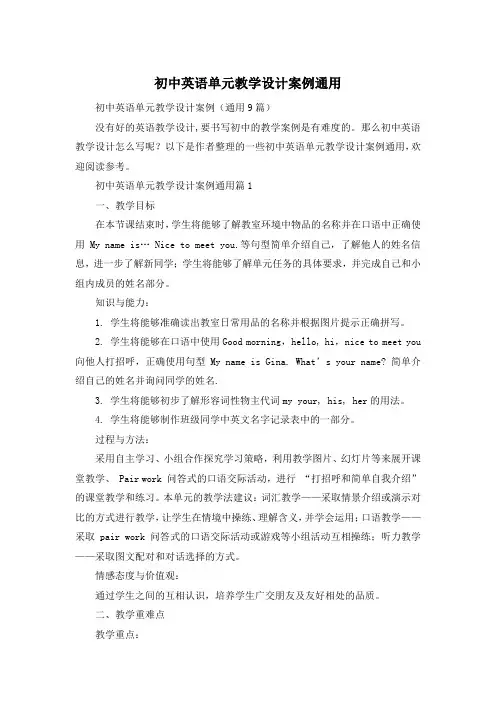
初中英语单元教学设计案例通用初中英语单元教学设计案例(通用9篇)没有好的英语教学设计,要书写初中的教学案例是有难度的。
那么初中英语教学设计怎么写呢?以下是作者整理的一些初中英语单元教学设计案例通用,欢迎阅读参考。
初中英语单元教学设计案例通用篇1一、教学目标在本节课结束时,学生将能够了解教室环境中物品的名称并在口语中正确使用My name is… Nice to meet you.等句型简单介绍自己,了解他人的姓名信息,进一步了解新同学;学生将能够了解单元任务的具体要求,并完成自己和小组内成员的姓名部分。
知识与能力:1. 学生将能够准确读出教室日常用品的名称并根据图片提示正确拼写。
2. 学生将能够在口语中使用Good morning,hello, hi,nice to meet you 向他人打招呼,正确使用句型My name is Gina. What’s your name? 简单介绍自己的姓名并询问同学的姓名.3. 学生将能够初步了解形容词性物主代词my your, his, her的用法。
4. 学生将能够制作班级同学中英文名字记录表中的一部分。
过程与方法:采用自主学习、小组合作探究学习策略,利用教学图片、幻灯片等来展开课堂教学、 Pair work 问答式的口语交际活动,进行“打招呼和简单自我介绍” 的课堂教学和练习。
本单元的教学法建议:词汇教学——采取情景介绍或演示对比的方式进行教学,让学生在情境中操练、理解含义,并学会运用;口语教学——采取 pair work 问答式的口语交际活动或游戏等小组活动互相操练;听力教学——采取图文配对和对话选择的方式。
情感态度与价值观:通过学生之间的互相认识,培养学生广交朋友及友好相处的品质。
二、教学重难点教学重点:1. 能够介绍自己的姓名:My name is …I’m…2. 能够简单问候初识的朋友:Hello!! Good morning! Nice to meet you!3. 能够正确使用形容词性物主代词my your, his, her三、教学策略词汇教学——采取情景介绍或演示对比的方式进行教学,让学生在情境中操练、理解含义,并学会运用;口语教学——采取 pair work 问答式的口语交际活动或游戏等小组活动互相操练;听力教学——采取图文配对和role-play的方式;四、教学过程略初中英语单元教学设计案例通用篇21、写课题(Topic)和课型(LessonType)课题相当于文章的标题,讲课时要首先告诉学生,并写在黑板上。
英语教学案例分析范文6篇初中
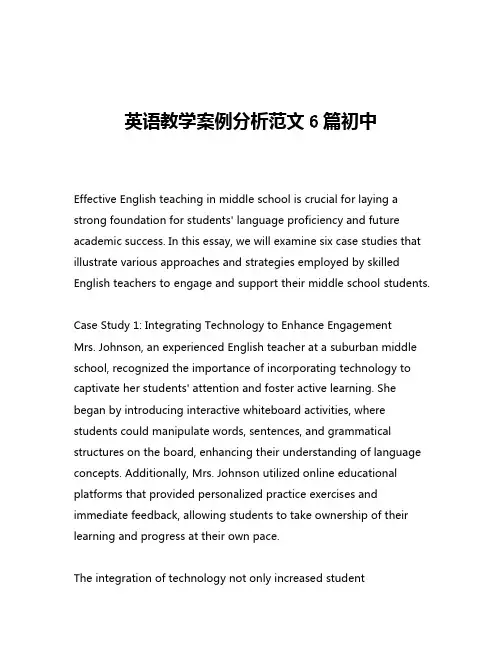
英语教学案例分析范文6篇初中Effective English teaching in middle school is crucial for laying a strong foundation for students' language proficiency and future academic success. In this essay, we will examine six case studies that illustrate various approaches and strategies employed by skilled English teachers to engage and support their middle school students.Case Study 1: Integrating Technology to Enhance Engagement Mrs. Johnson, an experienced English teacher at a suburban middle school, recognized the importance of incorporating technology to captivate her students' attention and foster active learning. She began by introducing interactive whiteboard activities, where students could manipulate words, sentences, and grammatical structures on the board, enhancing their understanding of language concepts. Additionally, Mrs. Johnson utilized online educational platforms that provided personalized practice exercises and immediate feedback, allowing students to take ownership of their learning and progress at their own pace.The integration of technology not only increased studentengagement but also enabled Mrs. Johnson to differentiate instruction and cater to diverse learning styles. Students who struggled with traditional pen-and-paper exercises found the digital activities more appealing and accessible, while those who thrived on independent learning benefited from the self-paced nature of the online resources. The result was a more dynamic and inclusive classroom environment, where all students felt empowered to participate and succeed in their English studies.Case Study 2: Fostering Critical Thinking through Literature Circles Mr. Patel, a middle school English teacher in a diverse urban setting, recognized the importance of developing his students' critical thinking skills. He implemented a literature circles approach, where students were divided into small groups and assigned different roles, such as discussion leader, connector, and literary analyst. Each group was responsible for reading a selected work of literature and engaging in collaborative discussions to unpack the themes, characters, and literary devices.The literature circles not only encouraged active engagement with the text but also cultivated essential communication and problem-solving skills. Students learned to listen actively, express their ideas clearly, and consider multiple perspectives. Mr. Patel's role shifted from a traditional lecturer to a facilitator, guiding the discussions and prompting students to delve deeper into the literary analysis.The success of this approach was evident in the students' increased confidence in expressing their interpretations and the depth of their literary analysis. Additionally, the collaborative nature of the literature circles fostered a sense of community and camaraderie among the students, further enhancing their overall learning experience.Case Study 3: Integrating Authentic Cultural ExperiencesIn a middle school with a growing population of English language learners, Ms. Garcia recognized the importance of incorporating authentic cultural experiences into her English lessons. She collaborated with the school's diversity committee to organize cultural celebrations and invite guest speakers from various backgrounds to share their stories and traditions.During these events, students had the opportunity to engage with the English language in a meaningful and contextual manner. They learned vocabulary and expressions related to the featured cultures, participated in interactive activities, and gained a deeper appreciation for the diversity within their school community. The cultural experiences also served as a platform for students to practice their speaking and listening skills in a low-stress, authentic setting.The integration of authentic cultural experiences not only improvedthe English language proficiency of the English language learners but also fostered a greater sense of inclusion and understanding among all students. The cross-cultural exchange and exposure to diverse perspectives enriched the learning environment and contributed to the overall growth and development of the students.Case Study 4: Differentiated Instruction for Struggling Readers Mrs. Nguyen, a middle school English teacher in a high-needs district, recognized the diverse learning needs of her students, particularly those who struggled with reading comprehension. She implemented a multi-tiered system of support, where she provided targeted interventions and differentiated instruction to address the individual needs of her students.For students who required additional support, Mrs. Nguyen utilized research-based reading strategies, such as guided reading, vocabulary development, and explicit instruction in phonics and fluency. She also incorporated the use of audiobooks, text-to-speech software, and graphic organizers to help struggling readers access the content and actively engage with the material.Mrs. Nguyen's dedication to differentiated instruction paid off, as her struggling readers demonstrated significant improvements in their reading abilities and overall academic performance. The individualized attention and tailored support not only boosted theirconfidence but also instilled a love for reading and learning.Case Study 5: Integrating Project-Based LearningMr. Goldstein, a middle school English teacher in a suburban setting, recognized the importance of making the English curriculum more relevant and engaging for his students. He implemented a project-based learning approach, where students were tasked with creating multimedia presentations on topics of their choice, ranging from social issues to literary analyses.The project-based learning approach allowed students to take an active role in their learning, as they conducted research, synthesized information, and utilized various technological tools to present their findings. Mr. Goldstein provided guidance and feedback throughout the process, ensuring that students developed essential skills, such as critical thinking, problem-solving, and effective communication.The project-based learning activities not only enhanced the students' engagement and motivation but also fostered their ability to collaborate, think creatively, and apply their knowledge to real-world situations. The final presentations showcased the students' diverse talents and perspectives, further enriching the learning environment.Case Study 6: Integrating Interdisciplinary ConnectionsMs. Lim, a middle school English teacher in a STEM-focused school,recognized the importance of integrating interdisciplinary connections to make the English curriculum more relevant and meaningful for her students. She collaborated with her colleagues from the science, mathematics, and social studies departments to develop cross-curricular lessons and projects.For example, in a unit on persuasive writing, Ms. Lim worked with the science teacher to have students research and write persuasive essays on environmental issues. The students not only honed their English language skills but also deepened their understanding of scientific concepts and their real-world applications. Similarly, in a poetry unit, Ms. Lim partnered with the art teacher to have students create visual representations of their poems, fostering their creativity and artistic expression.The integration of interdisciplinary connections not only enhanced the relevance and depth of the English curriculum but also encouraged students to see the interconnectedness of different subject areas. This approach helped students develop a more holistic understanding of the world around them and the role of language in various disciplines.In conclusion, the six case studies presented in this essay demonstrate the diverse and effective strategies employed by skilled English teachers in middle school settings. From integratingtechnology to fostering critical thinking, incorporating authentic cultural experiences, differentiating instruction, implementing project-based learning, and making interdisciplinary connections, these teachers have created dynamic and inclusive learning environments that support the academic and personal growth of their students. The success of these approaches underscores the importance of continuous professional development, collaboration, and a student-centered approach to English language instruction in middle schools.。
英语教学案例范文10篇
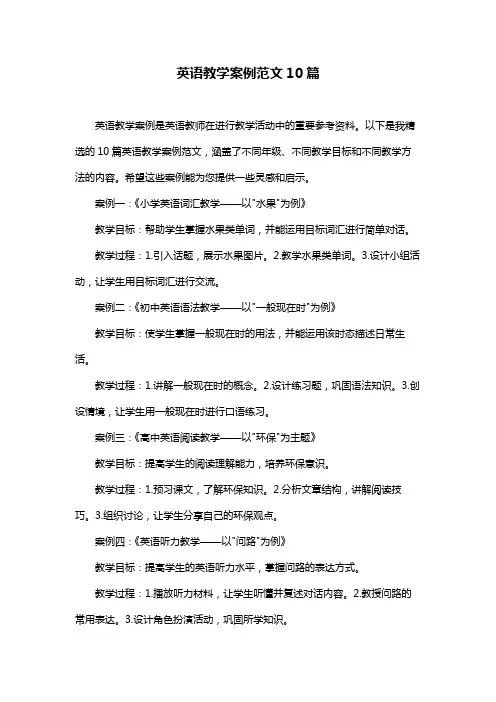
英语教学案例范文10篇英语教学案例是英语教师在进行教学活动中的重要参考资料。
以下是我精选的10篇英语教学案例范文,涵盖了不同年级、不同教学目标和不同教学方法的内容。
希望这些案例能为您提供一些灵感和启示。
案例一:《小学英语词汇教学——以"水果"为例》教学目标:帮助学生掌握水果类单词,并能运用目标词汇进行简单对话。
教学过程:1.引入话题,展示水果图片。
2.教学水果类单词。
3.设计小组活动,让学生用目标词汇进行交流。
案例二:《初中英语语法教学——以"一般现在时"为例》教学目标:使学生掌握一般现在时的用法,并能运用该时态描述日常生活。
教学过程:1.讲解一般现在时的概念。
2.设计练习题,巩固语法知识。
3.创设情境,让学生用一般现在时进行口语练习。
案例三:《高中英语阅读教学——以"环保"为主题》教学目标:提高学生的阅读理解能力,培养环保意识。
教学过程:1.预习课文,了解环保知识。
2.分析文章结构,讲解阅读技巧。
3.组织讨论,让学生分享自己的环保观点。
案例四:《英语听力教学——以"问路"为例》教学目标:提高学生的英语听力水平,掌握问路的表达方式。
教学过程:1.播放听力材料,让学生听懂并复述对话内容。
2.教授问路的常用表达。
3.设计角色扮演活动,巩固所学知识。
教学目标:培养学生的英语写作能力,学会用英语记录生活。
教学过程:1.讲解日记的格式和写作技巧。
2.提供写作素材,指导学生进行创作。
3.互相批改,提高写作质量。
案例六:《英语口语教学——以"旅游"为例》教学目标:提高学生的英语口语水平,学会用英语描述旅游景点。
教学过程:1.展示旅游景点图片,引导学生用英语进行描述。
2.教授相关表达,如:询问景点信息、推荐旅游景点等。
3.组织口语交流,让学生互相分享旅游经历。
案例七:《英语课堂教学游戏设计——以"猜词游戏"为例》教学目标:激发学生学习英语的兴趣,提高课堂参与度。
英语教学设计案例(共7篇)
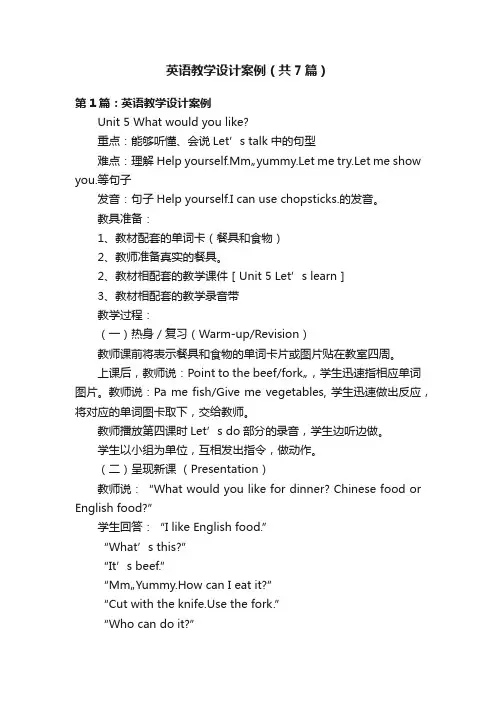
英语教学设计案例(共7篇)第1篇:英语教学设计案例Unit 5 What would you like?重点:能够听懂、会说Let’s talk中的句型难点:理解Help yourself.Mm…yummy.Let me try.Let me show you.等句子发音:句子Help yourself.I can use chopsticks.的发音。
教具准备:1、教材配套的单词卡(餐具和食物)2、教师准备真实的餐具。
2、教材相配套的教学课件[Unit 5 Let’s learn]3、教材相配套的教学录音带教学过程:(一)热身/复习(Warm-up/Revision)教师课前将表示餐具和食物的单词卡片或图片贴在教室四周。
上课后,教师说:Point to the beef/fork…,学生迅速指相应单词图片。
教师说:Pa me fish/Give me vegetables, 学生迅速做出反应,将对应的单词图卡取下,交给教师。
教师播放第四课时Let’s do部分的录音,学生边听边做。
学生以小组为单位,互相发出指令,做动作。
(二)呈现新课(Presentation)教师说:“What would you like for dinner? Chinese food or English food?”学生回答:“I like English food.”“What’s this?”“It’s beef.”“Mm…Yummy.How can I eat it?”“Cut with the e the fork.”“Who can do it?”教师拿出真实的餐具,让孩子试一试。
教师帮助孩子说:“ Let me try.”,请孩子来边试边说。
然后教师边示范边说:“Let me show you.”当孩子们理解了以上的句子,教师带着孩子们边演边说:“Mm…Yummy.I like beef.I can use the fork and the knife.Let me show you.”让孩子在小组中边演边说。
初中英语教学案例一等奖
初中英语教学案例一等奖(1)教学主题Unit 3 Our Hobbies Project English (仁爱八年级英语)Topic 1 What’s your hobby ? Section B教学对象Junior high school 8 grades教学功能Expressing students’ likes and dislikesLanguage pointsbe interested in 对……感兴趣used to do sth 过去常常做某事教学词汇Words to describe hobbiesTeaching strategies1. Collecting expressions2. Paying attention to students’ pronunciation教学课时 1Teaching procedureStep 1Warming up: using 10 minutes ask students about the hobbies,then let two or three groups make short dialogues. Students need to use the structuresStep 2First, using 5 minutes ask three students to make up the group,and read Section B 1a. then, using another 5 minutes listen to 1a.Michael : Hi,Maria!What are you carrying?Maria : It’s my stamp collection.Would you like to see it?Michael : Wow! What beautiful stamps!Are they all from China?Maria : Not all.I collected some of them from Cuba.But now I also have a lot of beautiful stamps from China.Michael : It must be fun.Maria : It certainly is.We can learn a lot about history and people from stamps.What hobbies did you used to have?Michael : I used to collect baseball cards.But now I’m interested in basketball.Kangkang: Hi,Maria! Hi,Michael!What are you looking at?Michael : Hi, Kangkang! We are looking at Maria’s stamps collection.Where are you going?Kangkang: I’m going swimming.It’s my favorite hobby.Step 3Show the target language:1. What’s you hobbies?2. I used to like/love/enjoy.....but now I hate it/don’t like/enjoy/love it.3. I am fond of/interested in......Step 4Listening :listen to 1a and circle true or false1. Maria only collects Chinese stamps. True2. Michael’s favorite hobby is playing baseball. False3. Kangkang is fond of swimming. False4. We can learn a lot about history and people from stamps. FalseStep 5V ocabulary : teaching students read the new words in 5minutes, and give them 5minutes to try to recite the new words.hobby (n.业余爱好,嗜好)poem (n.诗,韵文)maybe (adv.可能,也许)pet (n.宠物,宝贝)collect (v. 收集)hate (v.厌恶,讨厌)funny (adj.滑稽的,好笑的)friendship (n.友谊,友情)stupid (adj.愚笨的,笨的)ugly (adj.丑陋的,难看的)background (n.背景)paper (n.纸,纸张)scissors (n.剪刀)cut (v. 剪,切)glue (n.胶水)stick (v.粘贴,粘住)lazy (adj.懒惰的)passage (n.章节,段落)introduction (n. 介绍,引进)provide (v.提供,给予)pig (n.猪,贪婪的人)dirty (adj.肮脏的,污秽的)Step 6Exercise : read 1a and fill in the blanksMaria likes stamp when she is in Cuba. beautiful stamps! She thinks we can learn a lot about and from stamps. And she has many beautiful Chinese stamps. Michael used to baseball cards. But now he is in basketball. Kangkang is interested in .The three children have different .Maria likes stamp collection when she is in Cuba. beautiful stamps! She thinks we can learn a lot about history and people from stamps. And she has many beautiful Chinese stamps. Michael used to collect baseball cards. But now he is interested in basketball. Kangkang is interested in swimming.The three children have different hobbies.Step 7 ConclusionAfter class reflection: The lesson went on well. Students were quite excited and motivated. But not enough time was given at the practice, so some students didn’t have an chance to take part in the class activities. Some students also have difficulty making themself understood and their pronunciation are not good enough. It needs improve. More listening and practice are needed for those students in the next class.初中英语教学案例一等奖(2)Part One —— Analysis of the Teaching MaterialOne: Status and Function1. This unit tells us the improvement of traffic transportation and the related stories. Besides learning this, students will also learn some words, phrases and expressions of traffic, and so on. In Lesson 37, Danny will introduce a new type of transportation to us, it is imaginary.2. To attain “four skills” request of listening, speaking, reading and writing, I will have the students do some exercise about the text.3. Such a topic is very important in this unit. I will lead the students to use their imagination and encourage them to be creative. For example, helping them use English to describe their imaginary transportation. So I think if the students can learn this lesson well, it will be helpful to make them learn the rest of this unit.4. While teaching them, I will also encourage them to say something about what they think the future transportation will be like. In a way, from practising such a topic, it can be helpful to raise learning interests of students and it will be also helpful to improve their spoken language.Two: Teaching Aims and DemandsThe teaching aim’s basis is established according to Junior School English syllabus’ provision.1. To study the new words “fuel”, “oil” and “coal”.2. To learn and master the phrases “think of, on the way to …, have fun”, etc.3. To develop the students’ abilities of listening, speaking, reading and writing.4. To train the students’ ability of working in pairs.5. To develop the students’ abilities of communication by learning the useful structures.Three: Teaching Keys and Difficult PointsThe teaching keys and difficult points’ basis is established according to Lesson 37 in the teaching material's position and function.1. Key points:(1) Be able to express words, phrases and sentences in English.(2) Know about the improvement of transportation and Danny’s invention.2. Difficult points:Be able to talk about their imaginary future transportation in oral English.Part Two —— The Teaching Methods1. Communicative teaching method;2. Audio-visual teaching method;3. Task-based teaching method;4. Classified teaching method.As we all know: the main instructional aims of learning English in the Middle School is to cultivate students’ abilities of listening, speaking, reading, writing and their good sense of the English language. So in this lesson I’ll mainly use “Communicative” teaching method, “Audio-visual” teaching method and “Task-based” teaching method and “Classified” teaching method. That is to say, I’ll let the students get a better understanding of the key structures. I’llgive the students some tasks and arrange some kinds of activities, like talking, watching CAI, and reading in roles.In a word, I want to make the students the real masters in class while the teacher himself acts as director. I also hope to combine the language structures with the language functions and let the students receive some moral education while they are learning the English language.Part Three —— Studying ways1. Teach the students how to be successful language learners.2. Make situation and provide meaningful duty, encourage the students to study the text by themselves.Part Four —— Teaching stepsAs this lesson plays an important part in the English teaching of this unit, I have decided the following steps to train their ability of listening, speaking, reading and writing, especially reading and speaking ability.The entire steps are:Step 1 Warm-up and Lead-inShow the students some pictures of common transportation, like car, bike, train and so on. Ask the students: What can you see from the picture? Is there another kind of transportation around us?Purpose of my designing: In this part, have the students say more about what they see or what they don’t see. In this way, they will know today’s lesson has something to do with their discussion.Step 2 Presentation1. Learn new words in groups. The new word in this lesson are fuel, oil and coal. Show them pictures of these things and teach them these new words.Purpose of my designing: After seeing the pictures, the students will know what they are and they can learn them quickly and easily.2. Play the tape recorder. Let the students listen and imitate the text. Pay attention to their pronunciation and intonation. Then finish the exercises.Purpose of my designing: This step is employed to make the students get the general idea of the text. At the same time let the students have a chance to practise their listening and speaking ability.3. Text Learning and a QuizI’ll use CAI to present the whole text. I’ll write the key points on the blackboard while they are watching. After watching, I’ll teach them to read the words and sentences on the Bb. Make sure they can read them well.After teaching them the whole text, including the meanings of new words, the use of similar expressions and so on. Get the students to try and say out some phrases on the screen, like I don’t think so, have fun, a new kind of, on the way to school, and so on.Purpose of my designing: To present the text by CAI is much easier for the students to learn and grasp the meanings. CAI can provide a real situation with its sound and picture and it makes the relationships between the students better.4. Key Structures and Difficult Points LearningFirst, I will divide the students into three groups and tell them to have a discussion aboutwhat they learn in this lesson. Then encourage them to try to understand the whole text, know what the difficult points are, and so on. At last, I will help them to master them all.For example, I teach the students know the differences between phrases think of, think about and think over. I will show them some sentences and get them to know the use of these phrases. Encourage them to do some exercise about these phrases.Purpose of my designing: By practising using these new words and similar phrases, the students will know how to use them in English and master the use of them better.5. Read and SayGive the students two or three minutes to prepare, and then get them read the text together in three groups. Tell them to read aloud.Then help the students say something about the future transportation or their imaginary transportation. Encourage them to say more.Purpose of my designing: By reading the text and saying such things, get the students to practise their reading and speaking ability again.Part Five —— Summarize and HomeworkAsk the students such questions:What have we learned from this lesson? What does Danny say about his new kind / type of transportation? Do you like his idea? What new phrases have we learned today? Do you have enough confidence to finish these exercises? Now, let’s try!Then show them some exercises and help them to finish them.At last, tell the students what today’s homework is. While doing this, the teacher can have the boys and girls have a competition to see who are better.Part Six —— Blackboard DesigningLesson 37 Flying DonutsLanguage points:1.think of认为,想起think over仔细考虑think out想出2.at/in the front of在……前面(部)/ in front of在……前面3.on the way to school在上学的路上/ on one’s way home在回家路上4. With用……。
初中英语优秀教学案例
初中英语优秀教学案例案例一:使用多媒体教学提高研究兴趣背景学生在研究英语时通常会遇到兴趣不高的问题,因此教师需要采取一些创新的教学方式来提高学生的研究兴趣。
目标通过使用多媒体教学,激发学生对英语研究的兴趣,提高他们的研究效果。
方法1. 在课堂上使用多媒体设备,如投影仪或电脑等,展示与研究内容相关的图片、视频和音频。
2. 利用互动教学软件或在线课堂平台,设计有趣的互动活动,引导学生积极参与课堂。
3. 利用多媒体资源提供真实、生动的语言材料,帮助学生更好地理解和运用英语知识。
效果通过使用多媒体教学,学生对英语研究产生了浓厚的兴趣,表现出更高的参与度和积极性。
他们对研究内容的理解和记忆效果也明显提高。
案例二:小组合作研究促进口语能力的提升背景在英语教学中,口语能力的提升一直是一个挑战。
传统的教学方法往往无法充分激发学生的口语表达能力。
目标通过小组合作研究的方式,促进学生的口语能力,提高他们的英语交际能力。
方法1. 将学生分成小组,每个小组由4-5名学生组成。
每个小组内学生水平相近,可以相互帮助。
2. 设计有趣的口语练活动,如角色扮演、情景模拟等,让学生在小组内进行口语交流。
3. 教师担任辅导员的角色,引导学生进行有效的交流和互动,提供反馈和建议。
效果通过小组合作研究,学生的口语表达能力得到明显的提升。
他们在活动中表现出更大的自信和流利度,更积极主动地参与口语交流。
案例三:项目研究促进综合能力的提高背景仅仅掌握英语的基础知识往往无法满足学生的实际应用需求。
在教学中引入项目研究可以帮助学生提高综合能力。
目标通过项目研究,培养学生的综合应用能力,提高他们在实际情境中的语言运用水平。
方法1. 设计一个与学生实际生活或兴趣相关的英语项目,如旅行计划、文化交流等。
2. 将学生分为小组,每个小组负责完成一个项目,包括相关的研究、沟通和展示等。
3. 教师提供指导和支持,同时鼓励学生发挥创造力,积极参与项目实施过程。
效果通过项目研究,学生的综合能力得到显著提高。
初中英语教学案例分析(精选10篇)
初中英语教学案例分析(精选10篇)初中英语教学案例分析一、教学案例写作基础教师具有一定的教学基础理论,一定的写作基础知识,一定的教学教研经验,一定的分析研究能力。
总之,教师具备写作教学案例的基础。
只要教师认真研究,都有可能写出有价值的教学案例。
只要认真地运用教学理论深入分析教学案例,都有可能提出独到的见解。
撰写教学案例与撰写教学论文相比,写成的可能性,写好的可能性,获奖的可能性,发表的可能性,都要大得多。
二、初中英语教学案例分析(精选10篇)案例,就是人们在生产生活当中所经历的典型的富有多种意义的事件陈述。
它是人们所经历的故事当中的有意截取。
下面是小编为大家整理的初中英语教学案例分析(精选10篇),仅供参考,希望能够帮助到大家。
初中英语教学案例分析1摘要:主要阐述了在农村初中英语教学中,如何创造有利于学生学习的心理状态,形成积极的学习态度,课堂教学中如何发挥英语学科的思想性和人文性,体现育人价值。
通过教师有效运用各种激励方法,培养学生积极的学习心向,构建和谐的师生关系,整体提高英语教学效益,努力促进学生智商和情商的发展。
关键词:主动学习;初中英语;英语教学【案例片段】思考的问题:课堂教学之中如何发挥英语学科的思想性和人文性,体现育人价值?笔者整理了日常英语教学中的一些案例片段并加以分析和思考,旨在寻找英语学科的育人价值。
片段一:上课之前,我先让学生听一首英文歌曲:happy birthday!然后我就问:what’s the best gift you have everreceived?when did you get it?who gave it to you?片段二:学生个个热情高涨,发表自己的看法。
请大家谈谈应该送什么礼物给自己的同学和朋友,庆祝生日,并相互评价,是否合理。
片段三:我布置的家庭作业,是学生回家以后,调查家里人的生日:what should i get my father/mother?what about…why don’t you…【教学反思】关于生日礼物,大多数学生都很清楚,但是应该送什么礼物,多数学生没有思考过这一问题,教师有意让学生进行思考和讨论。
2024年初中英语教学案例(优秀8篇)
2024年初中英语教学案例(优秀8篇)初中英语教学案例篇一一、关注学生情感,创造民主、和谐的教学气氛。
学生只有对自己、对英语及其文化有积极的情态,才能保持英语学习的动力并取得成绩,刻板的情态,不仅会影响英语学习的效果,还会影响其它发展,情态是学好英语的重要因素,因此我努力创造宽松民主、和谐的教学空间,做到:1、尊重每个学生,积极鼓励他们在学习中的尝试,保护他们的自尊心和积极性。
2、把英语教学与情态有机地结合起来,创造各种合作学习的活动,促进学生互相学习,互相帮助,体验成就感,发展合作精神。
3、关注学习有困难的或性格内向的学习,尽可能地为他们创造语言的机会。
4、建立融洽、民主的师生交流渠道,经常和学生一起反思学习过程和学习效果,互相鼓励和帮助,做到教学相关。
二、面向全体学生,为学生全面发展和终身发展奠定基础。
1、创设各种情景,鼓励学生大胆地使用英语,对他们在学习过程中的失误和错误采取宽容的态度。
2、为学生提供自主学习和直接交流的机会,以及充分表现和自我发展的一个空间。
3、鼓励学生通过体验、实践、合作、探索等方式,发展听、说、读、写的综合能力。
4、创造条件让学生能够探究他们自己的一些问题,并自主解决问题。
三、加强对学生学习策略的指导,让他们在学习和适用的过程中逐步学会如何学习做到:1、积极创造条件,让学生参与到阶段性学习目标,以及实现目标的方法。
2、引导学生结合语境,采用推测、查阅和协调的方法进行学习。
3、引导学生在学习过程中,进行自我评价,并根据需要调整自己的学习目标和学习策略。
四、对学生进行有效的评价。
评价可以使学生认识自我,树立自信,有助于反思及调整自己的学习过程,评价或采用测验及非测验形式,平时重视形成性评价,对学生回答学习过程中的表现所改进的诚绩,及反映的情感、态度、策略某方面进行及时的评价,如有口头评价、等级评价、学生之间互相评价等方法,充分发觉学生的进步,鼓励学生自我反思,自我提高,测验以学生综合运用能力为目标,侧重于学生理解和获取信息,能力减少客观题,增加主观题,通过评价学生学会分析自己的成绩和不足,明确努力方向。
- 1、下载文档前请自行甄别文档内容的完整性,平台不提供额外的编辑、内容补充、找答案等附加服务。
- 2、"仅部分预览"的文档,不可在线预览部分如存在完整性等问题,可反馈申请退款(可完整预览的文档不适用该条件!)。
- 3、如文档侵犯您的权益,请联系客服反馈,我们会尽快为您处理(人工客服工作时间:9:00-18:30)。
以下案例在任务设计、阅读、听力教学等方面有许多可取之处,提供给大家,供参考。
在格式方面请根据所提供格式安排!Unit 6 How do you get to school乳山市诸往初中李静一、教材分析本单元的中心话题是“Transportation”,围绕“How do you get to school”,“How long does it take”,“Howfar is it”层层展开,并采用“任务型语言教学途径”,编排了一系列凸现“交际功能(Talk about how to get to school)”运用的听说读写综合语言活动,让学生学会谈论如何到达某个地方,距离有多远,要花多长时间等等。
这些活动紧贴学生的生活实际,极具真实性,从而使学生的个人经历成为课堂学习的有效图式,有助于学生对所获取的声音和文字英语信息的理解;有助于调动他们用英语表达自己的经验和感受兴趣和热情;有助于促进他们语言功能的运用;有助于提高他们为应用而主动学习和掌握语言知识(词汇和语法结构等)的兴趣。
在教材编排上,Section A是基础,是底线,是学生必须掌握的目标语言;而Section B是Section A的扩展和引申,通过任务型听力来讨论交通工具及方式的最佳组合方式,并通过任务型阅读帮助学生了解不同国家学生上学的交通工具及方式的异同。
二、教学目标1.语言目标词汇:subway, take the subway, train, minute, how far, quick, leave for, half, past, bus station, bus ride, stop, bust stop, north,school bus, by boat, must, car, ill, worry句式:How do you get to school I ride my bike.How long does it take It takes ten minutes.How far is it from your home to school It’s about 10 kilometers.2.能力目标(1) 能够谈论如何到达目的地。
(2) 能够谈论自己的日常生活。
(3)能够有效地获取信息和处理信息。
3.情感目标(1) 学会关注生命与安全;培养时间观念,学会珍惜时间。
(2) 了解朋友及家人的生活。
4.跨学科学习(1) 社会实践:学习距离、交通方式的表达。
(2) 个性培养:学会合理安排自己的生活,培养时间观念,学会珍惜时间。
(3) 跨文化研究:了解不同国家、不同地区学生上学的交通工具及方式的异同。
三、教学重、难点通过语言目标的学习,学会谈论如何到达目的地,如何表达距离的远近,如何表达到某地花多长时间,并在生活实际中正确运用所学语言。
四、教法与学法1. 采用情境法、交际法和“任务型”教学途径,使“英语学习任务化,学习活动生活化”,通过设置多样化的任务,巧妙注意任务的序列性,让学生在教学活动中参与和完成真实的生活任务,从而培养学生运用英语的能力,(用英语做事的能力)。
在教学过程中,坚持“以人为本”,关注学生的情感,关注学生的发展,把说的机会留给学生,把思考的时间还给学生,把做的权利交给学生。
2. 充分发挥多媒体辅助教学的优势,集图片、声音、动画于一体,使课堂教学更为形象,更为直观,更为生动,学生更有兴趣,印象也会更深。
3. 采用小组合作的学习方式,让学生学会交流,学会分享,学会合作,并有效地避免班额过大、不同学生之间知识水平和智力发展参差不齐,同时师生之间、学生之间的交际得不到充分发挥等问题。
五、教学程序设计课时安排及任务设置核心任务及任务链根据本单元学习有关交通方面的内容,设计核心任务为“2000元欢乐假日行”,形成如下任务链:了解周围的人是如何到校、如何上班的——选择适合自己的交通工具或交通工具组合方式——威海一日游——说明不同国家、不同地区学生上学的交通工具及方式的异同——2000元欢乐假日行——比较交通工具的特点与优劣势——向政府提出合理建议,改善交通环境。
第一课时第一课时以听说为主,教学目标为:1.学会谈论如何到达某地,学会谈论自己、朋友、家人如何上学、工作; 2.熟练掌握到达某地要花多长时间的表达,学会谈论自己的生活;3.学会合作,了解朋友和家人的生活;4.学会关注生命与安全;培养时间观念,学会珍惜时间。
本课的核心任务是Know more about your friends ,并通过How do you get to school How does he/she get to school How long does it take 三个小任务组成的任务链完成任务前的准备,课堂流程如下所示:Pre-class Activities课前要求学生通过各种途径收集有关交通工具的名称和图片,并利用词典或金山词霸来认读单词。
不仅培养了学生收集信息和处理信息的能力,而且使学生在这一过程中能够主动地参与学习,拓宽视野,实现英语学习的生活化。
Warming-up Activities1.新单元总会让每一个学生迫不急待,即将开始的学习内容往往让他们倍感好奇。
教师要善于把握学生的这种心理,通过有效地设置问题来引导学生识读主图:①What can you see in the picture②Guess, when is it now, morning, afternoon or evening Why③I think it’s winter now, what about your opinion How do you know that④Look at the boy in a red cap, what does he look like What is he doing⑤Can you see the girl in pink What is she doing Guess, where is she going⑥Where is the girl with short blond hair Can you find something strange Why is she sitting in a wheelchair What can we do for her⑦What does “TERMINAL” mean⑧How many kinds of transportation can you see in the picture显然,读图的目的并非仅仅是导入课堂教学,更重要的是巧妙地运用课本所提供的课程资源,尽可能多地为学生提供“说英语”的机会,帮助他们逐步养成英语思维习惯。
2.通过小组合作的学习方式,交流彼此所收集的信息,实现资源共享,并通过讨论小组命名和小组竞赛两个小活动来帮助学生进一步熟悉目标词汇。
3.最后选用节奏活泼、边说边做的Chant,(内容如下)Go, go, let’ go!Ride, ride, ride my bike.Take, take, take the bus.Take, take, take the subway.…使学生在不知不觉中强化识记了有关交通工具的词汇和词块,而且也是对其后进行的Lucky 52游戏作了一次简单热身。
Task 1: How do you get to school教师首先借助多媒体课件呈现本课的目标句型How do you get to school,同时利用图片使学生掌握ride a bike, take the bus, take the train, take a plane, take a car等词块,并学会对目标句型做出正确应答,然后由课件演示引出目标句型的第二种答语,并通过Match the sentences(如下所示)的形式,小步快一个有梯度的序列,不经意间便完成了本课的第二个任务:Task 2: How does he/she get to school /How do they get to school 熟悉目标语言后,迅速进入听和写的训练。
1.首先设置以下问题:Look at the picture, so many students go to school in the morning.Now let’s think how they get to school.How does the boy get to schoolHow does the girl get to schoolHow do the boy and the girl get to school…引导学生有针对性地第二次读图,然后完成1a的书写训练。
2.听前对录音材料进行简要的背景介绍:This time you will listen to a conversation. Two people are talking about how some students get to school. 使学生对所听内容有所预知,有所了解,从而降低了学生听的难度,使学生轻轻松松地完成任务型听力1b。
3.听力任务完成后,用大屏幕呈现完整的听力材料,让学生反复跟读录音,语音、语调、句型熟练后,改成两人一组看图自由对话。
4.最后采用学生喜闻乐见的“Lucky 52”的游戏方式,将全班分为A, B, C 三组进行活动:A组面向大屏幕,并试着用动作表演屏幕所显示的交通工具,背对屏幕的C组回答B组所提问题How does he/she get to school,也可以用Does he/she take the subway/take the bus进行猜测,在规定时间内未能完成的小组将有一位本组成员被淘汰,最后人数多者胜出。
这个活动使学生的积极性瞬间被调动,那种一猜再猜而又未猜中,想得到真实答案的欲望也更加强烈,在竞猜中习得了前两个任务所学习的目标语言。
Task 3: How long does it takeSay: D ifferent students get to school in different ways, but you must be on time for school. You must pay close attention to time.这样适时地对学生进行了情感教育,培养了学生的时间观念,也为后部分的学习作了成功导入。
1.借助直观教具闹钟,并用手指拨动指针行走来呈现句型“How long does it take”,并训练时间的表达,更具直观性和生活性。
2.听力无疑是学生的“老大难”,在随后进行的2a和2b的听力训练前,首先引导学生通过谈论图片来预测所听问题,有效地降低听力难度。
